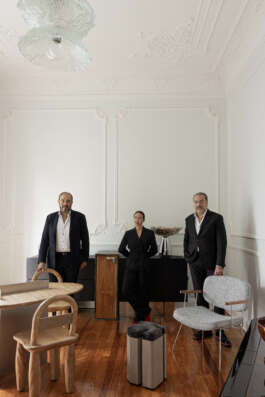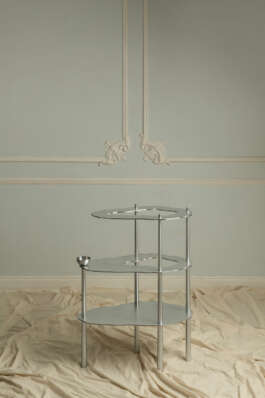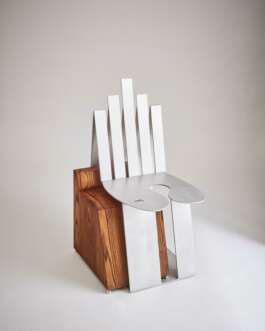



©Alejandro Ramirez
COLLECTIBLE In-Depth
Toro Manifesto
August 2025
This series, COLLECTIBLE In-Depth, unveils the backstage of contemporary creation. Tackling various topics from personal designer processes to the position of collectible design on the global design market, COLLECTIBLE In-Depth offers different views to suit all tastes. Today we speak with Toro Manifesto.
C: Why do you focus on contemporary collectible design? What does it mean for you?
Toro Manifesto: For me, contemporary collectible design is not just about creating beautiful objects — it’s about giving them voice, intention, and soul. I have always believed that objects can hold memory, emotion, and identity; that a chair, a lamp, or a tray can be as powerful as a painting when it’s born from a strong concept. At Toro Manifesto, we see design as an amulet of our time: something that transcends function and becomes part of a personal narrative.
We are drawn to the space where the contemporary meets heritage where craft, history, and experimentation merge into a single gesture. In our vision, ornament, materiality, and storytelling are not excess, but essential. We embrace the retrofuturist idea that the past never truly leaves us; it mutates, reappears, and reinvents itself. In that tension between memory and possibility, collectible design becomes a cultural statement — intimate, daring, and enduring.
C: How did you get into collectible design? Why did you start your gallery?
TM: My relationship with objects began in childhood, quietly observing the homes of my grandparents, where every piece seemed to speak without words. Later, I started collecting what others might have considered obsolete: forgotten treasures from antique markets, everyday shops, or the living rooms of friends.
Those encounters revealed to me a silent language — the poetry hidden in the everyday. Years of traveling with Horacio and Arturo deepened this vision. In cities like Brussels and Amsterdam, we experienced design as a cultural extension — intimate yet provocative, capable of carrying the same weight as fine art. These journeys planted the seed for Toro Manifesto: born from conversations, from the urge to create something of our own, and from the realization that good taste alone was not enough we needed a powerful, authentic identity.
C: What tip would you give to young designers who wish to focus their practice on collectible design?
TM: Don’t be afraid to follow what truly moves you. The most powerful story you can tell is the one that is yours — pieces that reflect who you are, born from your own voice and inspiration. Avoid chasing trends, popular materials, or mass-appeal forms. Speak from your own sensibility, even if at first it feels slow or unfamiliar.
In collectible design, authenticity is everything. It’s about creating work that cannot be mistaken for anyone else’s — work that holds its own because it comes from a place of truth. And when something is powerful, it will find its audience.
C: How can collectible design be a representation or reaction to the current societal, political or economic questions?
TM: The objects present in a space can embody a context in themselves. They help us understand how societies have been shaped — how someone’s perception evolves through travel, or how they value local artisanal processes. They can reveal a preference for technology or for more rustic craftsmanship, reflecting what they see in their country or surroundings.
Objects also speak to someone`s personal stance toward situations — what moves them, and what they seek to mirror back into their own society. In this way, collectible design becomes both a reflection and a dialogue: a physical manifestation of cultural identity, influence, and perspective.
C: Can you talk about a designer, whom you admire (designers)?
TM: One of the designers I deeply admire is Ben Storms. His work was pivotal in helping me understand collectible design on a deeper level. What fascinates me most is his ability to merge highly artisanal techniques with advanced technological processes creating objects that feel both timeless and forward-looking.
Storms pushes the boundaries of materiality, challenging the notion that objects must always be perceived in familiar ways. By taking materials to their limits bending, shaping, and reimagining them, he creates forms that force us to reconsider what we thought we knew. His work is a reminder that innovation often lies in daring to question tradition while still honoring craftsmanship.

© Mariana Achach

© Kiki Goti

©Alejandro Ramirez
COLLECTIBLE In-Depth
Toro Manifesto
August 2025
This series, COLLECTIBLE In-Depth, unveils the backstage of contemporary creation. Tackling various topics from personal designer processes to the position of collectible design on the global design market, COLLECTIBLE In-Depth offers different views to suit all tastes. Today we speak with Toro Manifesto.
C: Why do you focus on contemporary collectible design? What does it mean for you?
Toro Manifesto: For me, contemporary collectible design is not just about creating beautiful objects — it’s about giving them voice, intention, and soul. I have always believed that objects can hold memory, emotion, and identity; that a chair, a lamp, or a tray can be as powerful as a painting when it’s born from a strong concept. At Toro Manifesto, we see design as an amulet of our time: something that transcends function and becomes part of a personal narrative.
We are drawn to the space where the contemporary meets heritage where craft, history, and experimentation merge into a single gesture. In our vision, ornament, materiality, and storytelling are not excess, but essential. We embrace the retrofuturist idea that the past never truly leaves us; it mutates, reappears, and reinvents itself. In that tension between memory and possibility, collectible design becomes a cultural statement — intimate, daring, and enduring.
C: How did you get into collectible design? Why did you start your gallery?
TM: My relationship with objects began in childhood, quietly observing the homes of my grandparents, where every piece seemed to speak without words. Later, I started collecting what others might have considered obsolete: forgotten treasures from antique markets, everyday shops, or the living rooms of friends.
Those encounters revealed to me a silent language — the poetry hidden in the everyday. Years of traveling with Horacio and Arturo deepened this vision. In cities like Brussels and Amsterdam, we experienced design as a cultural extension — intimate yet provocative, capable of carrying the same weight as fine art. These journeys planted the seed for Toro Manifesto: born from conversations, from the urge to create something of our own, and from the realization that good taste alone was not enough we needed a powerful, authentic identity.
C: What tip would you give to young designers who wish to focus their practice on collectible design?
TM: Don’t be afraid to follow what truly moves you. The most powerful story you can tell is the one that is yours — pieces that reflect who you are, born from your own voice and inspiration. Avoid chasing trends, popular materials, or mass-appeal forms. Speak from your own sensibility, even if at first it feels slow or unfamiliar.
In collectible design, authenticity is everything. It’s about creating work that cannot be mistaken for anyone else’s — work that holds its own because it comes from a place of truth. And when something is powerful, it will find its audience.
C: How can collectible design be a representation or reaction to the current societal, political or economic questions?
TM: The objects present in a space can embody a context in themselves. They help us understand how societies have been shaped — how someone’s perception evolves through travel, or how they value local artisanal processes. They can reveal a preference for technology or for more rustic craftsmanship, reflecting what they see in their country or surroundings.
Objects also speak to someone`s personal stance toward situations — what moves them, and what they seek to mirror back into their own society. In this way, collectible design becomes both a reflection and a dialogue: a physical manifestation of cultural identity, influence, and perspective.
C: Can you talk about a designer, whom you admire (designers)?
TM: One of the designers I deeply admire is Ben Storms. His work was pivotal in helping me understand collectible design on a deeper level. What fascinates me most is his ability to merge highly artisanal techniques with advanced technological processes creating objects that feel both timeless and forward-looking.
Storms pushes the boundaries of materiality, challenging the notion that objects must always be perceived in familiar ways. By taking materials to their limits bending, shaping, and reimagining them, he creates forms that force us to reconsider what we thought we knew. His work is a reminder that innovation often lies in daring to question tradition while still honoring craftsmanship.

© Mariana Achach

© Kiki Goti
Contact
info@collectible.design
VIP PORTAL
EXHIBITOR PORTAL
PRIVACY POLICY
© 2025 Collectible
Contact
info@collectible.design
VIP PORTAL
EXHIBITOR PORTAL
PRIVACY POLICY
© 2025 Collectible